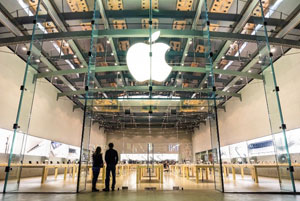Imprinted on the cover of "The Hitchhiker's Guide to the Galaxy" - the fictional "standard repository for all knowledge and wisdom" in the comedic sci-fi series of the same name by Douglas Adams - is the phrase "Don't Panic."
Arthur C. Clarke ("2001: A Space Odyssey", "Rendezvous with Rama"), a British science-fiction author even more renowned than Adams, called it the "best advice" that could be given to humanity.
He was right.
 That's why the same sentiment is behind Rule No. 2 of our five-part investing system, which says to "separate the signal from the noise."
That's why the same sentiment is behind Rule No. 2 of our five-part investing system, which says to "separate the signal from the noise."
And I hope you followed that rule back in the summer of 2015, when it seemed like all of Wall Street and Silicon Valley were panicked over Apple Inc. (Nasdaq: AAPL).
At the time, the so-called "experts" said the sun was about to set on the world's most valuable tech franchise - and fled its stock in droves.
However, if you followed along here and combined our tech wealth-building strategies when it came to Apple, then you're sitting on some huge gains.
If you're new around here, you can do the same thing.
Entirely Like a Huge Fortune
As someone who's followed Apple for more than 30 years, I was stunned by the number of analysts and investors alike who shunned the Silicon Valley legend a few years back.
But if you'd been following along with me here, you wouldn't have been surprised last week when Apple reported record sales.
And you would have already picked up shares at a discount...
Apple's big rebound proves the power of two of the key investing themes at Strategic Tech Investor.
The first is Rule No. 2. The other is our Cowboy Split buying system designed to turn market overreactions into cash in the bank.
And today, I'm going to show you just how to combine these two tools so you, too, can rack up consistent market-crushing gains...
Now then, you should probably know that I am still considered one of the biggest Apple bulls around. Indeed, I got quite a bit of notoriety back in early 2014 when I became the first analyst to predict that Apple shares would go to $1,000.
I put that price tag on before the stock split 7-to-1 in June 2014 for an adjusted price of $142.85. My target date was Labor Day 2016.
How did I do?
Pretty Close
The stock got within $8.31 of my forecast on April 28, 2015, before then selling off.
Yes, my ego took a slight hit. However, I stand by my price target, though it will clearly take Apple longer to get there than I first thought.
 I believe much of the "delay" we're seeing is because of Wall Street's "noise." One analyst after another opined that, under CEO Tim Cook, Apple is no longer an innovative firm.
I believe much of the "delay" we're seeing is because of Wall Street's "noise." One analyst after another opined that, under CEO Tim Cook, Apple is no longer an innovative firm.
To make that statement shows a lack of knowledge about Apple's history. Let's start how the firm turned the world on its ear in 1984 with the Mac.
The first truly consumer-friendly personal computer was a great self-contained platform that didn't need any extra programming and featured the breakthrough mouse. However, it is important to note that Steve Jobs "borrowed" much of the ideas for the iconic device from the famed Palo Alto Research Center (PARC) run by Xerox Corp. (NYSE: XRX).
Jobs was later forced out of the company. Then, when he returned in late 1996 to chart its revival, Apple was on the ropes. But it took him five years to come up with the "next big thing" - the iPod digital music player that debuted in October 2001.
In other words, Apple didn't break much new ground for 17 years. And the iPod was not the first portable digital music player. That claim belongs to the MPMan F10, a device that South Korea's Saehan Information System Inc. launched in March 1998.
Apple is credited with creating the smartphone when it debuted the iPhone in June 2007. Again, it was not the first phone of its kind, but it was by far the "best-of-breed" and became the standard by which all wireless devices would be judged.
Are you sensing a pattern here?
Apple is rarely first to market.
Instead, the company has a genius for taking existing technology and then refining it and redesigning it into useful, intuitive, and fun products that get consumers to line up to buy one.
Keep Your Towel Handy
In the Adams "Hitchhiker" mythos, those who "Don't Panic" are said to "know where one's towel is."
That is, people who don't panic - those who are in control of just about every situation - always knows where their towel is. They don't have to worry about the big stuff because they've already taken care of the small stuff.
So, if you always know where your towel is - if you've focused on "the signal" and turned off "the noise" - you'd have seen that Apple has been quietly adding new revenue streams that most other tech companies can only dream about.
It's also a cash machine that is rewarding investors with a 2.2% dividend and billions in share buybacks.
For a while there, the Apple bears looked smart - on paper at least. After all, the firm had three quarters in a row of falling sales, a rare event for this leader.
But last week, the embattled giant bounced right back. Sales of the iPhone jumped 5% from the year-ago period, helping the firm rack up record quarterly sales of $78.4 billion.
Not only that, but Apple's high-margin Services unit saw an 18% sales jump to $7.2 billion. That's more than three times the sales that all of Netflix Inc. (Nasdaq: NFLX) had over the same stretch.
Yes, profits were off 2.6%, but this occurs as Cook is ramping R&D spending up fourfold as he invests in the next round of breakouts.
Here's where all these crucial facts come to play. Had you ignored the noise on Wall Street, you'd have seen what I saw - that Apple's share-price decline was nothing short of a great buying opportunity.
It's the exact kind of set up I look for so that readers of this column and my two paid services - Nova-X Report and Radical Technology Profits - can add to their long-term gains in quality stocks.
Rounding Up Profits
And as I said before, this "case study" also shows why my Cowboy Split buying system is so profitable.
It's a classic investment strategy with a new nickname to reflect our focus on the "New West" of Silicon Valley tech stocks.
Properly employed, the Cowboy Split will protect you from volatile markets.
Here's how it works. We buy a first tranche at market and then put in a lowball limit order to buy more shares when they correct, generally after the stock is down 20%.
In other words, what for Wall Street would be a 20% stop-loss becomes a 20% discount for us.
Had you put my Cowboy Split into place when Apple peaked at $132.65 on a closing basis on April 27, 2015, your lowball would have triggered at $106 almost exactly four months later.
The good news is that, after falling a bit further, the stock has come roaring back as Wall Street regained its senses.
Since it hit a closing low of $90.34 on May 12, 2016, Apple has surged 42.9%. By contrast, the S&P 500 Index is up 11.3% over the same period.
That means a stock Wall Street hated less than two years ago smashed the broad market's returns during the period by an amazing 280%.
That's why we follow along here and through my paid services - to learn the tips and strategies that will put us far ahead of the pack.
To learn how to make companies like Apple part of your tech-centric wealth machine.
So we all thank Douglas Adams for his immortal advice - and I thank you for meeting me here twice each week.
I'll see you again on Friday.
Have a great week.
Follow me on Facebook and Twitter.
Related Reports:
- Strategic Tech Investor Special Report: Your Tech Wealth Blueprint
- Strategic Tech Investor Special Report: The "Cowboy Split"
- Strategic Tech Investor Video: Why Apple Stock Will Hit $1,000 in Two Years
- Strategic Tech Investor: This May Be Your "Last, Best" Chance to Buy Apple at a Bargain
The post Why "Don't Panic" Is the Best Advice You'll Ever Get appeared first on Strategic Tech Investor.
About the Author
Michael A. Robinson is a 36-year Silicon Valley veteran and one of the top tech and biotech financial analysts working today. That's because, as a consultant, senior adviser, and board member for Silicon Valley venture capital firms, Michael enjoys privileged access to pioneering CEOs, scientists, and high-profile players. And he brings this entire world of Silicon Valley "insiders" right to you...
- He was one of five people involved in early meetings for the $160 billion "cloud" computing phenomenon.
- He was there as Lee Iacocca and Roger Smith, the CEOs of Chrysler and GM, led the robotics revolution that saved the U.S. automotive industry.
- As cyber-security was becoming a focus of national security, Michael was with Dave DeWalt, the CEO of McAfee, right before Intel acquired his company for $7.8 billion.
This all means the entire world is constantly seeking Michael's insight.
In addition to being a regular guest and panelist on CNBC and Fox Business, he is also a Pulitzer Prize-nominated writer and reporter. His first book Overdrawn: The Bailout of American Savings warned people about the coming financial collapse - years before the word "bailout" became a household word.
Silicon Valley defense publications vie for his analysis. He's worked for Defense Media Network and Signal Magazine, as well as The New York Times, American Enterprise, and The Wall Street Journal.
And even with decades of experience, Michael believes there has never been a moment in time quite like this.
Right now, medical breakthroughs that once took years to develop are moving at a record speed. And that means we are going to see highly lucrative biotech investment opportunities come in fast and furious.
To help you navigate the historic opportunity in biotech, Michael launched the Bio-Tech Profit Alliance.
His other publications include: Strategic Tech Investor, The Nova-X Report, Bio-Technology Profit Alliance and Nexus-9 Network.



